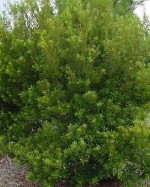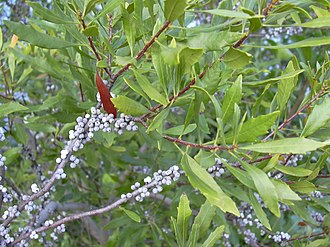
Also called southern bayberry, candleberry, bayberry tree, and tallow shrub, this evergreen shrub or small tree is a native of wetlands in Southeastern United States. It is a member of the Myricaceae, a small family of shrubs and trees that also includes sweetfern. The plants grow 10-25′ tall and have thin, smooth gray-green to whitish bark, and leathery, light olive green leaves that are 3-6″ long, aromatic, and have toothed margins. In spring, inconspicuous, male and female catkins with apetalous flowers are produced on different plants and by the fall the female flowers develop a globular fruit with a wax-like coating that has been used for candle-making since colonial times. The berries are attractive to birds. Wax myrtle is grows well in wet to moderately dry soil, and is tolerant of shade, salt, high wind, and lean soil so is valued for a wide range of landscape situations especially seaside gardens. The leaves, stems and branches contain flammable compounds so the plant is considered a fire hazard and should not be planted near buildings. The genus name, Myrica, is from the ancient Greek word μυρίκη (muríkē) meaning tamarisk. The specific epithet, cerifera, comes from the Latin words cera meaning wax, and ferre meaning to bear, and refers to the coating on the fruits. Photo Credit Wikipedia

Type: Evergreen shrub or small tree
Outstanding Features: Fast growth; toughness
Form: Vase-shaped to round
Growth Rate: Very rapid
Bloom: Small inconspicuous flowers in spring followed by small blue-gray, wax covered berries (on female plants only)
Foliage: Simple, oblong, glossy, green, aromatic leaves, 2-4” long.
Size: 10-25’ H
Light: Full sun to partial shade
Soil: Average, well-drained, slightly acidic
Hardiness: Zones 7B-10
Care: Pruning produces stronger structure
Pests and Diseases: None of significance; caterpillars and mites may attack the foliage; high pH soil may result in yellowing of leaves
Propagation: Seed, tip cuttings, division
Outstanding Selection: `Pumila’ (dwarf form)
Comments: Salt tolerant; tolerates occasional flooding.
